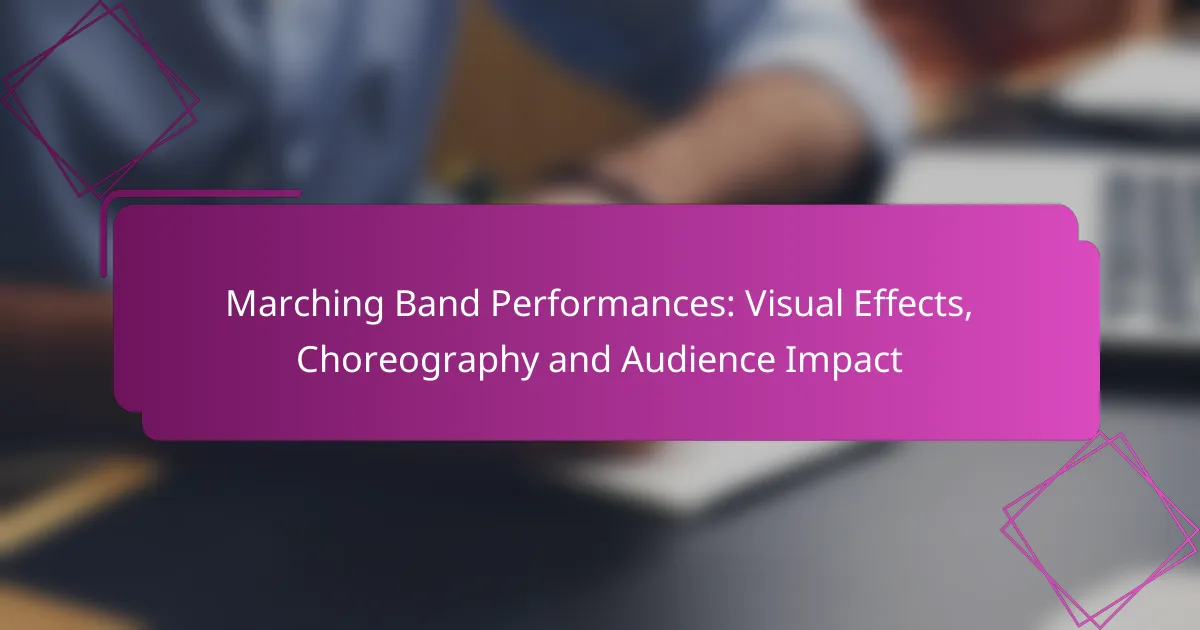Marching band performances are transformed into captivating spectacles through the use of visual effects and innovative choreography, which together create an immersive experience for the audience. By incorporating dynamic formations, dance elements, and thematic visuals, these performances not only enhance aesthetic appeal but also forge emotional connections with spectators. The impact of these elements is measured through audience feedback and engagement metrics, highlighting the significance of performance artistry in resonating with viewers.

How do visual effects enhance marching band performances?
Visual effects significantly enhance marching band performances by creating a more immersive and engaging experience for the audience. These effects can elevate the overall aesthetic, complement the music, and convey themes, making the performance more memorable.
Use of LED technology
LED technology has transformed marching band performances by providing vibrant colors and dynamic visuals. Bands can use LED lights integrated into uniforms or props to create synchronized light shows that align with the music, enhancing the emotional impact of the performance.
When implementing LED technology, consider the power source and weight, as these factors can affect mobility during the performance. Bands often opt for lightweight, battery-operated LED systems to maintain agility while still delivering impressive visual effects.
Integration of projection mapping
Projection mapping allows bands to project images and animations onto surfaces, creating stunning visual backdrops that enhance storytelling. This technique can be used to transform the field into various environments, adding depth and context to the performance.
To effectively use projection mapping, ensure that the projection equipment is compatible with outdoor settings and can withstand varying light conditions. Planning the visuals to align with the music and choreography is crucial for a cohesive performance.
Impact of color and lighting
Color and lighting play a vital role in setting the mood and tone of a marching band performance. Different colors can evoke specific emotions, while strategic lighting can highlight key moments or performers, drawing the audience’s attention where it matters most.
When selecting colors and lighting schemes, consider the theme of the performance and the time of day. For evening performances, brighter, more saturated colors can stand out better, while softer hues may be more effective in daylight.
Examples from competitive events
Many competitive marching band events showcase the effective use of visual effects. For instance, bands at the Bands of America Grand National Championships often incorporate advanced LED displays and intricate choreography that synchronize with their music, creating a captivating experience.
Reviewing past performances can provide inspiration and insight into successful visual strategies. Look for bands that have received high scores for visual performance to understand how they integrate effects seamlessly into their routines.
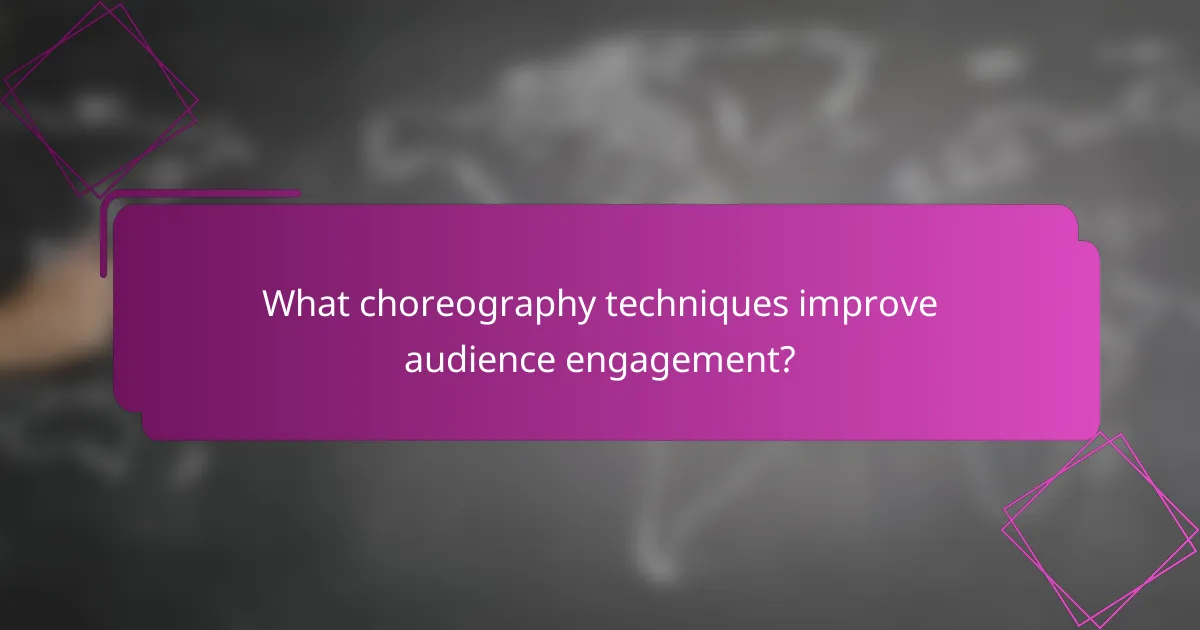
What choreography techniques improve audience engagement?
Choreography techniques that enhance audience engagement include dynamic formation changes, the incorporation of dance elements, and the effective use of props and staging. These techniques create visual interest and emotional connections, making performances more memorable and impactful.
Formation changes and transitions
Formation changes and smooth transitions are essential for maintaining audience interest. By frequently altering shapes and patterns, performers can create a sense of movement and excitement. Consider using formations like circles, lines, or diagonals to keep the visual flow engaging.
Effective transitions between formations should be seamless and well-rehearsed. A common pitfall is abrupt changes that disrupt the performance’s rhythm. Aim for transitions that complement the music and enhance the overall narrative of the show.
Incorporation of dance elements
Integrating dance elements into marching band performances can significantly elevate audience engagement. Dance styles such as jazz, contemporary, or hip-hop can add energy and flair, making the performance more relatable and enjoyable. Ensure that the dance movements align with the music’s tempo and mood for maximum impact.
When incorporating dance, consider the skill level of your performers. Start with simple movements that can be executed confidently, then gradually introduce more complex choreography as their skills improve. This approach helps maintain a polished appearance while building performers’ confidence.
Use of props and staging
Props and staging can enhance the visual storytelling of a marching band performance. Items like flags, banners, or themed props can add layers of meaning and interest. Choose props that complement the overall theme and are easy for performers to handle while marching.
When planning staging, consider the layout of the performance area. Ensure that props are placed strategically to enhance visibility and impact without obstructing performers’ movements. Regularly practice with props to avoid mishaps during live performances, which can detract from audience engagement.
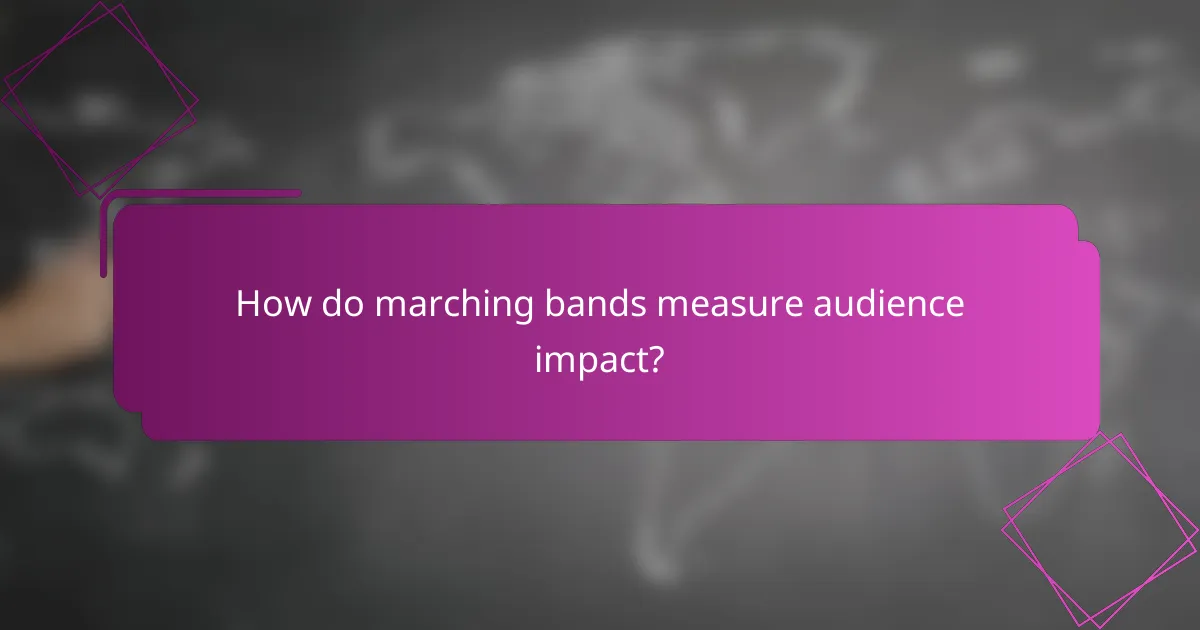
How do marching bands measure audience impact?
Marching bands measure audience impact through various methods that gauge how well their performances resonate with spectators. Key indicators include direct feedback, social media interactions, and attendance statistics, all of which provide insights into audience engagement and satisfaction.
Audience feedback and surveys
Collecting audience feedback through surveys is a direct way to understand their experience during a performance. Bands can distribute questionnaires after shows, asking attendees to rate aspects like music quality, visual effects, and overall enjoyment. This feedback can help identify strengths and areas for improvement.
In-person feedback can also be valuable; engaging with the audience after a performance allows for real-time insights. Consider asking open-ended questions to gather qualitative data that surveys might miss.
Social media engagement metrics
Social media platforms serve as a powerful tool for measuring audience impact through engagement metrics. Likes, shares, comments, and follower growth can indicate how well a performance resonates with viewers online. Bands should track these metrics regularly to assess their reach and influence.
Additionally, creating engaging content, such as behind-the-scenes videos or performance highlights, can boost interaction. Monitoring hashtags related to performances can also provide insights into audience sentiment and engagement levels.
Ticket sales and attendance figures
Ticket sales and attendance figures are critical indicators of a marching band’s audience impact. High ticket sales typically reflect strong interest and engagement, while attendance numbers can reveal trends over time. Bands should analyze these figures to understand their market appeal and adjust strategies accordingly.
Comparing attendance figures across different performances can highlight which events draw larger crowds. Consider factors like venue size and ticket pricing, as these can significantly influence sales and turnout. Regularly reviewing these metrics helps bands plan future performances more effectively.

What are the best practices for integrating visual effects and choreography?
Integrating visual effects and choreography in marching band performances enhances the overall impact and audience engagement. Best practices include close collaboration among team members and effective rehearsal strategies to ensure synchronization.
Collaboration between designers and choreographers
Effective collaboration between visual designers and choreographers is crucial for a cohesive performance. Designers should understand the choreography’s flow and intent, while choreographers need to be aware of the visual elements that will accompany their movements. Regular meetings and brainstorming sessions can help align their visions.
Utilizing shared tools, such as digital design software or collaborative platforms, can streamline communication. This ensures that both parties can visualize the performance as a unified piece rather than separate components.
Rehearsal strategies for synchronization
Synchronization is key to a successful integration of visual effects and choreography. Rehearsals should include specific segments dedicated to practicing visual cues alongside the choreography. This allows performers to become accustomed to timing and transitions.
Consider using a metronome or visual countdowns during rehearsals to help maintain tempo and coordination. Additionally, breaking down complex sequences into smaller, manageable parts can facilitate learning and improve overall performance quality.
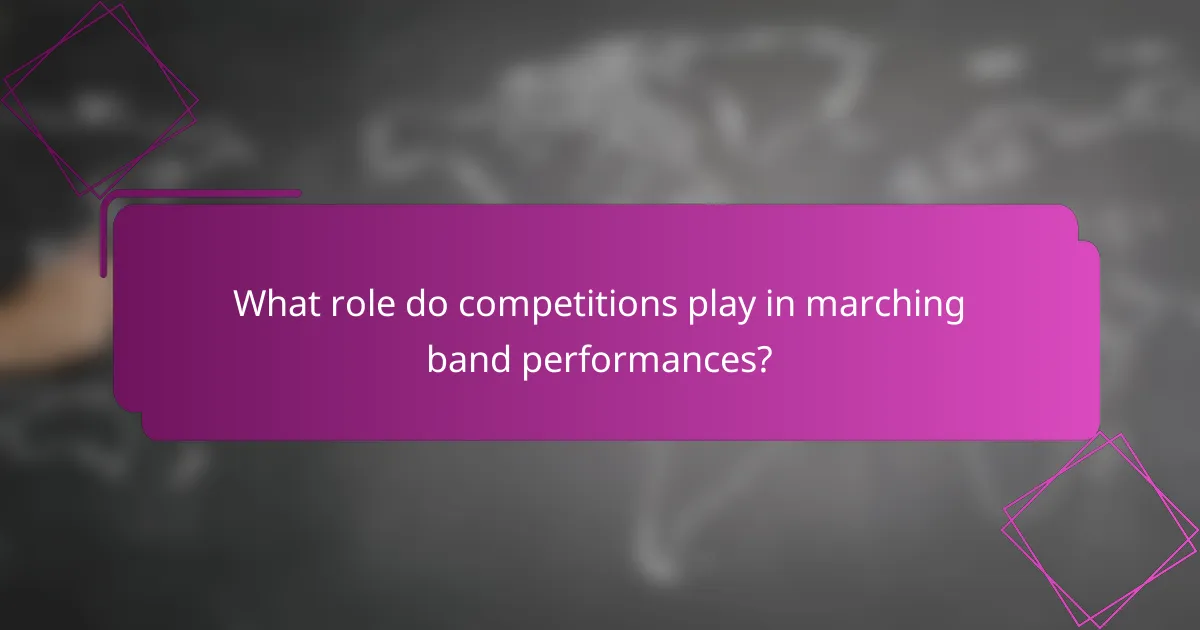
What role do competitions play in marching band performances?
Competitions are crucial for marching band performances as they provide a structured environment for evaluation and improvement. They motivate bands to enhance their visual effects and choreography while offering feedback from judges that can lead to growth and innovation.
Judging criteria for visual effects
Judges assess visual effects based on several criteria, including overall design, execution, and integration with music. Key elements often include formations, transitions, and the use of props or color guard. Bands typically aim for a balance between creativity and clarity to maximize their scores.
Commonly, judges look for how well the visual elements complement the musical score, ensuring that the performance is cohesive. For example, a band might use specific formations to highlight musical crescendos or dramatic moments, enhancing the audience’s experience.
Impact of competitive pressure on creativity
Competitive pressure can significantly influence a band’s creativity, pushing them to innovate in their performances. While some bands thrive under this pressure, leading to unique and memorable shows, others may feel constrained, resulting in more conventional routines.
To harness competitive pressure positively, bands should focus on collaboration and brainstorming sessions, encouraging all members to contribute ideas. This approach can lead to fresh concepts that stand out in competitions, ultimately enhancing their visual storytelling and audience engagement.
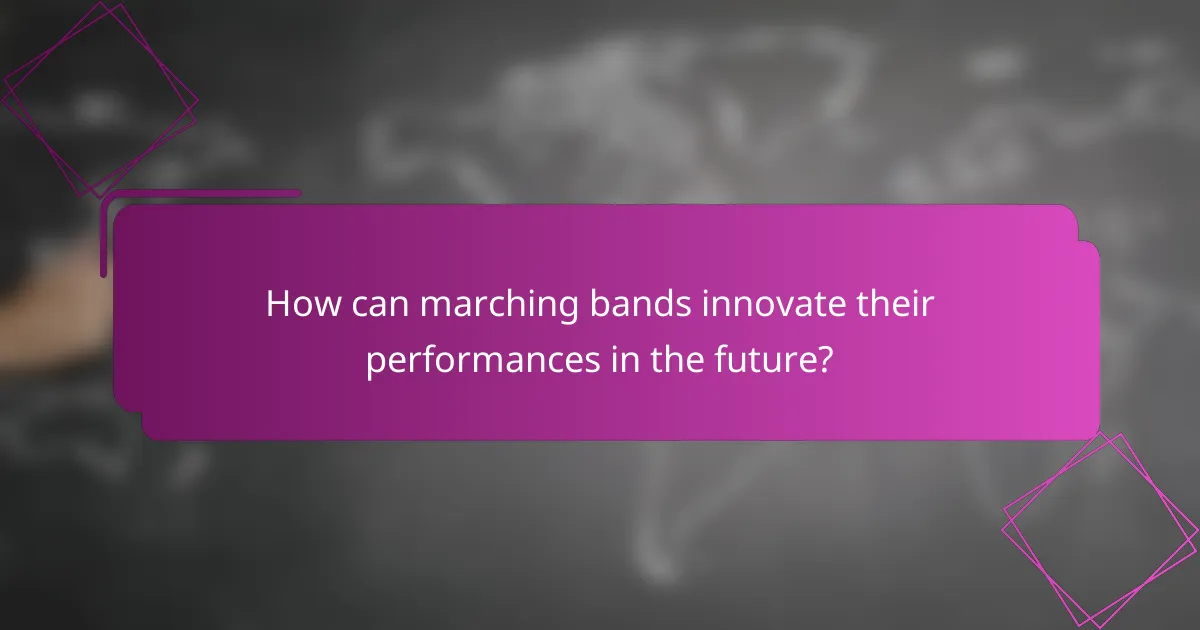
How can marching bands innovate their performances in the future?
Marching bands can innovate their performances by incorporating advanced technology, unique visual effects, and dynamic choreography. These elements can enhance audience engagement and create memorable experiences that go beyond traditional music displays.
Incorporating Technology
Utilizing technology such as drones, LED displays, and augmented reality can significantly elevate a marching band’s performance. For example, drones can create stunning aerial visuals that complement the music, while LED screens can display synchronized graphics that enhance the overall theme.
When integrating technology, bands should ensure that it aligns with their musical goals and does not distract from the performance. A balanced approach that harmonizes technology with traditional elements can lead to a captivating show.
Enhancing Visual Effects
Visual effects play a crucial role in captivating audiences. Bands can experiment with color guard routines, props, and costumes that reflect the theme of their performance. For instance, using vibrant colors and coordinated movements can create a striking visual narrative.
Additionally, incorporating lighting effects, such as spotlights or color washes, can enhance the emotional impact of the performance. Bands should consider the venue’s lighting capabilities when planning these effects to ensure they are effective and safe.
Dynamic Choreography
Choreography is essential for creating a visually engaging performance. Bands can innovate by incorporating complex formations and synchronized movements that tell a story or convey a specific theme. This could involve using formations that change rapidly or integrating dance elements into the performance.
To achieve dynamic choreography, bands should focus on clear communication and practice. Regular rehearsals that emphasize timing and synchronization can help ensure that all members are in sync, leading to a polished and impressive performance.
Engaging the Audience
Audience engagement is vital for a successful performance. Marching bands can innovate by involving the audience through interactive elements, such as call-and-response segments or inviting audience members to participate in simple movements. This interaction can create a more immersive experience.
Additionally, bands should consider their performance location and tailor their show to resonate with the local audience. Understanding the cultural context and preferences of the audience can enhance the overall impact of the performance.
